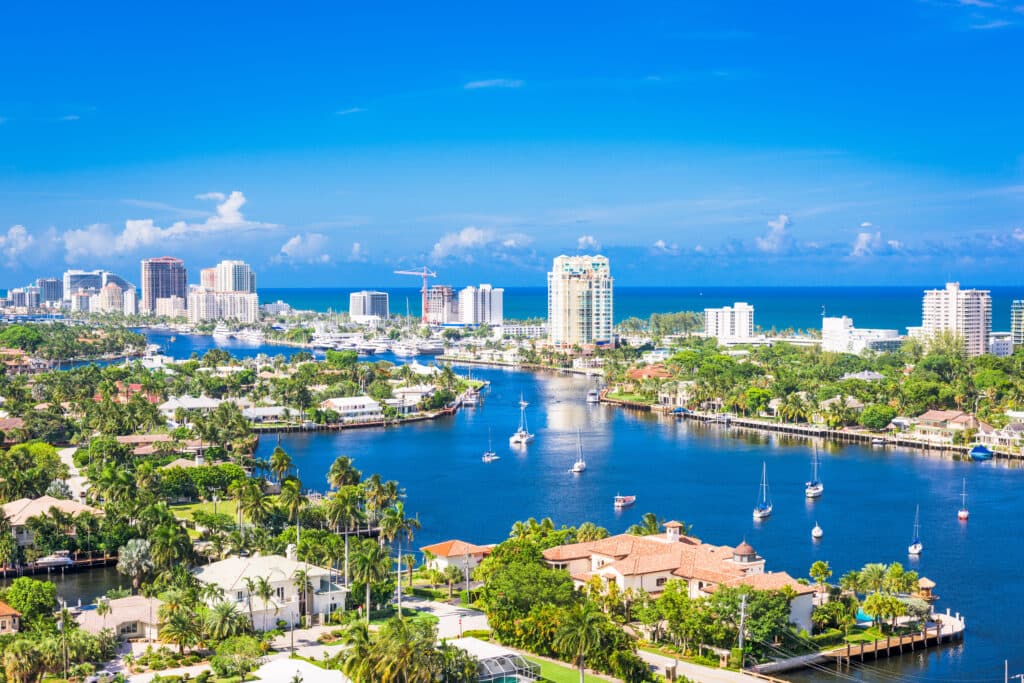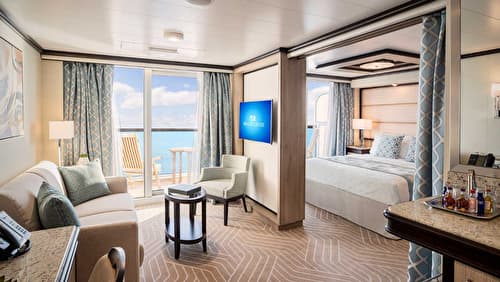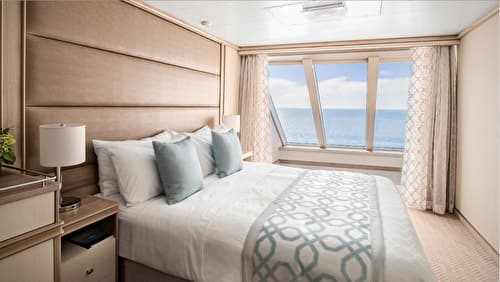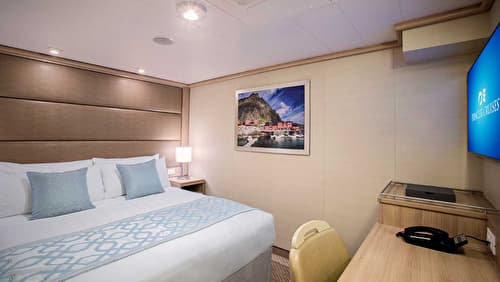Mediterranean & Greek Isles Grand Adventure
- calendar_today 16 Apr ‘27 (46 nights)
- clear_night 46 nights
- directions_boat Departing from Fort Lauderdale on Enchanted Princess
Inside price from
£4,168*
/ppOutside price from
£5,152*
/ppBalcony price from
£4,872*
/ppSuite price from
£7,545*
/ppPremium Cruise Line Call to add Princess Plus or Princess Premier packages
Your Itinerary

According to the popular 1960 beach movie, Fort Lauderdale is “where the boys are.” The city’s reputation as America’s Spring Break capital, however, has been replaced with the more favorable image of a prime family tourist destination, attracting more than 10 million visitors annually. The most popular beach resort in Florida is even more rightly famed as the “Yachting Capital of the World,” with more than 40,000 registered crafts calling its waters home. The city also prides itself on being the “Venice of America” with more than 300 miles of navigable waterways. Fort Lauderdale boasts world-class theaters, museums, sightseeing, and shopping.
Swim with the dolphins, snorkel alongside a rainbow of fish or take in historic sights like the Royal Navel Dockyard.
Rising from the depths of the Atlantic, the rugged, volcanic Azores lie 800 miles off the coast of Portugal. Colonized by the Portuguese in the 16th century, the nine islands have provided a haven to Atlantic mariners for over five centuries. The Azores offer travelers spectacular landscapes that range from lush meadows fringed with brightly colored hydrangea to ancient caldera filled with lakes. And the many small villages and shops retain an otherworldly air and 18th-century charm.
Ponta Delgada is located on São Miguel, the largest of the nine Azores. The island’s rich volcanic soil sustains fields of tobacco and tea, vineyards, and pineapple greenhouses. The Azores are also noted for fine crafts, particularly basketry and pottery.
The Rock crouches over the sea like an ancient stone beast, looking Sphinx-like to Africa. Beneath the white cliffs of this natural fortress grows a profusion of palm, pine, and cypress. No fewer than 600 varieties of flowers thrive here, some not found anywhere else on Earth. Gibraltar’s stunning setting is matched by its history – five countries have battled for 13 centuries to control the passage between the Atlantic and the Mediterranean. The result made for a cultural melting pot. Veiled Moroccan women in caftans and vacationing Englishmen and Spaniards stroll along the narrow, steep lanes. The locals revert to a liquid Spanish when talking among themselves. And visitors to a 15th-century cathedral pass through a blue-tiled courtyard, once part of a 13th-century mosque.
Cartagena is an ancient port – the city served as Hannibal’s Spanish headquarters during the 2nd Punic War with Rome. The city remained a major trading port under the Romans and the Moors. Today, Cartagena is Spain’s principal naval establishment and the site of an annual international maritime festival. The city is also your gateway to the Costa Calida, a region that boasts some of Spain’s mildest weather along with 175 miles of beaches.
Your gateway to the Eternal City, Civitavecchia has served as Rome’s seaport since the 13th century. The port has a long and venerable history. The emperor Trajan built a pleasure villa near the modern city, while Bernini and Michelangelo designed the harbor fortifications.
Yet the Eternal City eternally beckons. The ancient capital of the Western World and the center of Christianity for nearly 2,000 years, Rome provides an inexhaustible feast. Visit the ruins of the Forum, view the splendors of the Sistine Chapel, or climb the Spanish Steps, once the heart of Rome’s Bohemian Quarter.
Rome has been a magnet luring the world’s greatest artists, architects, and philosophers since the days of the Caesars.
Livorno is the gateway to glorious Tuscany. Visit Florence – the cradle of the Renaissance – home to the Duomo, the Uffizi and the Ponte Vecchio. Here the Medici fostered a city-state whose cultural legacy is as great as classical Athens. Giants like Dante, Da Vinci, Michelangelo and Galileo infused the West with a new creative spirit. Then there is Pisa, Florence’s rival for political power. Pisa, a brash, commercial seafaring town rivaled the great maritime powers of Venice and Genoa. The city was a leader in art and architecture second only to Florence.
Sardinia is the second largest island in the Mediterranean. Like its neighbor Corsica, Sardinia boasts a dramatic coastline, superb small harbors and beaches that draw visitors from around the world. Gaunt hills crowned with granite outcropping take up most of the island interior, though the landscape is broken by vineyards and groves of olive trees and cork oaks. The island’s harsh beauty is counterpointed by its rich culture – the island boasts extensive prehistoric ruins, fine Pisan churches and medieval walled towns. For centuries, Italian city-states and Spain vied for control of Sardinia. The old port of Alghero has a distinctive Catalan feel – it was known as “Little Barcelona.” The Albi Palace was a residence for the Spanish viceroys who governed Sardinia. Alghero is an anchorage port. Passengers transfer to shore via ship’s tender.
Malta is the largest in a group of seven islands that occupy a strategic position between Europe and Africa. The island’s history is long and turbulent. Everyone from the Normans to the Nazis have vied for control of this small, honey-colored rock. For centuries the island was the possession of the knightly Order of St. John – the Knights Hospitaller. Valletta, Malta’s current capital, was planned by the Order’s Grandmaster Jean de la Valette to secure the island’s eastern coast from Turk incursions. Founded in 1566, Valletta’s bustling streets are lined with superb Baroque buildings and churches.
Malta has a long history: the megalithic stone temples at Gozo may be the oldest freestanding structures on Earth. Malta has two official languages, Maltese (constitutionally the national language) and English. Malta was admitted to the European Union in 2004 and in 2008 became part of the eurozone.
Kotor lies at the head of Boka Bay. Bordered by towering limestone cliffs, the winding bay is actually Southern Europe’s longest and most dramatic fjord. The port itself is a medieval gem: its narrow, asymmetrical streets are lined with ancient stone houses, old palaces, and churches dating from the 12th century. Kotor is also your gateway to the cultural and scenic wonders of Montenegro, from the old royal capital at Cetinje to the marshes and wildlife of Lake Skadar National Park.
Kotor is renowned for its nightlife: the streets of the old port are lined with pubs, taverns and cafés. The city is also host to a renowned summer carnival.
Kotor is an anchorage port. Passengers transfer to shore via ship’s tender.
Dubrovnik is a beautiful stone jewel hugging the Adriatic Sea. This picture-perfect medieval walled city offers ancient stone buildings, narrow cobbled streets and fortified ramparts rising above red-tiled rooftops. Stradun is the city’s focal point and main artery while Dubrovnik’s streets are blessedly free of vehicular traffic. Despite the heavy damage inflicted by shelling in the early ’90s, Dubrovnik has been restored to its pre-war beauty. A UNESCO World Heritage Site, the old city remains the pride of the Republic of Croatia. For six centuries Dubrovnik was an independent republic – an oligarchy ruled by patrician families. The Republic was overthrown by Napoleon in 1808.
Pine-clad hills, secluded coves, beaches – Split and the Dalmatian Riviera have been premier destinations on the Adriatic since the days of the Roman emperors. In fact, medieval Split was built within and around the palace complex built for the emperor Diocletian in his retirement. (The complex included both a villa and a castrum – a Roman camp capable of garrisoning three legions!) The charms that soothed an emperor are still evident today. The Dalmatian Riviera offers the traveler a heady blend of natural beauty and fascinating cultural sites.
Trieste is the capital city of the Friuli Venezia Giulia region in northeast Italy. A port city, it occupies a thin strip of land between the Adriatic coast and Slovenia’s border on the limestone-dominated Karst Plateau. Italian, Austro-Hungarian and Slovenian influences are all evident in its layout, which encompasses a medieval old city and a neoclassical Austrian quarter.
Pine-clad hills, secluded coves, beaches – Split and the Dalmatian Riviera have been premier destinations on the Adriatic since the days of the Roman emperors. In fact, medieval Split was built within and around the palace complex built for the emperor Diocletian in his retirement. (The complex included both a villa and a castrum – a Roman camp capable of garrisoning three legions!) The charms that soothed an emperor are still evident today. The Dalmatian Riviera offers the traveler a heady blend of natural beauty and fascinating cultural sites.
Kotor lies at the head of Boka Bay. Bordered by towering limestone cliffs, the winding bay is actually Southern Europe’s longest and most dramatic fjord. The port itself is a medieval gem: its narrow, asymmetrical streets are lined with ancient stone houses, old palaces, and churches dating from the 12th century. Kotor is also your gateway to the cultural and scenic wonders of Montenegro, from the old royal capital at Cetinje to the marshes and wildlife of Lake Skadar National Park.
Kotor is renowned for its nightlife: the streets of the old port are lined with pubs, taverns and cafés. The city is also host to a renowned summer carnival.
Kotor is an anchorage port. Passengers transfer to shore via ship’s tender.
The lush and verdant island of Corfu lies in the Ionian Sea, midway between Greece and Italy. The island has a long and colorful history. First colonized by the city-state of Corinth, Corfu has been ruled by the Romans, the Venetians, the French and the English. Corfu Town boasts fortresses bearing the insignia of the Venetian Republic, an esplanade lavishly planted by the French during the Napoleonic Wars, and an English cricket pitch. The island also offers some of the finest coastal scenery in the entire Mediterranean.
Perched on the west coast of the Peloponnesus, Greece’s largest peninsula, this sleepy fishing village of some 300 souls is your gateway to Olympia, site of the original Olympic Games. Held every four years between 776 B.C. and 393 A.D., when the Emperor Theodosius banned pagan festivals, the Olympic Games celebrated the ideal harmony of mind and body. Every four years, the sacred flame of Altis is rekindled to light the torch for the Modern Games.
Olympia’s temples were destroyed after the games were banned. An earthquake in the 6th century compounded the destruction, and floods buried the site. Excavation of the ruins began in 1875, and Olympia was declared a National Park in 1976.
Chania is a city on the northwest coast of the Greek island of Crete. It’s known for its 14th-century Venetian harbor, narrow streets and waterfront restaurants. At the harbor entrance is a 16th-century lighthouse with Venetian, Egyptian and Ottoman influences. Opposite, the Nautical Museum has model ships, naval objects and photographs.
Did the catastrophic volcanic eruption that ravaged Santorini circa 1600 B.C. destroy Crete’s ancient Minoan civilization – and give birth to the myth of Atlantis? In 1967, archaeologists on Santorini unearthed the remains of a Bronze Age city that may have been home to as many as 30,000 people. Whether the Lost Continent of Atlantis is rooted in myth or reality, an undisputed fact remains. The eruption created a caldera – and one of the most dramatic land and seascapes in the entire Mediterranean. On Santorini, whitewashed buildings cling to vertiginous cliffs that plunge to a turquoise sea. Part of the Cyclades Archipelago, the three-island group of Santorini, Thirasia and uninhabited Aspronisi present the traveler with unforgettable vistas.
The island has had a number of names throughout history – from Strongyle or “Round” to Thera in honor of an ancient hero. Santorini is more recent and stems from the island church dedicated to St. Irene – Santa Rini to foreign sailors.
The largest and arguably the most beautiful of the 12 islands forming the Dodecanese, Rhodes has long played a major role in history. Lying just 12 miles off the coast of Turkey, the island straddles the sea-lanes linking Egypt, Southern Europe and the Holy Land. Rhodes Town bears witness to that long history. The ancient city features a classical stadium and the ruins of the Temple of Apollo. The “old” city is a walled town with medieval buildings and streets harking back to the days of the Crusades. The new town is a Mecca of luxury resorts lining the island’s picturesque Mandaraki Harbor.
The Colossus of Rhodes, one of the Seven Wonders of the Ancient World, is reputed to have once stood guard over the harbor. Today, the bronze statues of a stag and doe top the two columns marking the harbor entrance.
Limassol, the second-largest city in Cyprus and the biggest port in the Mediterranean transit trade, is an important tourist and commercial hub. Flanking Akrotiri Bay on the island’s southern coast, the town sprawls between two ancient cities, Amathus and Kourion.
From the port of Kusadasi on Turkeys Anatolian Coast, one travels into the past. Nearby stand the ruins of ancient Ephesus, a major site of archeological excavation. The city was once a Roman provincial capital and trading center. Ephesus is also home to several of Christendoms holiest sites. St. Paul preached at the Great Theater and the ruins of Ephesus Basilica cover the tomb of Christs most beloved disciple, St. John the Apostle. In Kusadasi, whitewashed stone houses rise in tiers behind the market district. The palm-lined esplanade is the center of town life, with thousands of merchants offering wares to rival the Grand Bazaar in Istanbul.
The past maintains a vibrant presence in the cradle of Western civilization. Atop the Acropolis, the serene Parthenon sails above the commotion of the modern city. The tragedies of Aeschylus, Sophocles, and Euripides were performed in the Theater of Dionysus at the foot of the Acropolis. On Pnyx Hill, citizens of a fledgling democracy gathered to cast their votes on Athens’ destiny. Then there is the hustle and bustle of the modern city, a metropolis of 4.5 million that spreads out from the foot of Mt. Lycabettus and across the plain. Packed with busy shops and lively tavernas, modern Athens is a colorful counterpoint to classical Greece.
Piraeus is the port city for Athens and has been Athens’ port of entry for over two millennia.
Chania is a city on the northwest coast of the Greek island of Crete. It’s known for its 14th-century Venetian harbor, narrow streets and waterfront restaurants. At the harbor entrance is a 16th-century lighthouse with Venetian, Egyptian and Ottoman influences. Opposite, the Nautical Museum has model ships, naval objects and photographs.
Perched on the west coast of the Peloponnesus, Greece’s largest peninsula, this sleepy fishing village of some 300 souls is your gateway to Olympia, site of the original Olympic Games. Held every four years between 776 B.C. and 393 A.D., when the Emperor Theodosius banned pagan festivals, the Olympic Games celebrated the ideal harmony of mind and body. Every four years, the sacred flame of Altis is rekindled to light the torch for the Modern Games.
Olympia’s temples were destroyed after the games were banned. An earthquake in the 6th century compounded the destruction, and floods buried the site. Excavation of the ruins began in 1875, and Olympia was declared a National Park in 1976.
Messina has played a major role in European history since its founding as a Greek colony in the 8th century B.C. During the Roman Empire, the city was a major port and commercial center, during the Middle Ages, Messina was the major port of departure for Crusaders. History has also left its scars: a massive earthquake leveled much of the city in 1908 and the World War II campaign for Sicily devastated Messina. Yet Messina emerged from that devastation with some of its historic treasures intact, including the 12th-century Annunziata dei Catalani Church. Messina is also your gateway to the rugged beauty of southeast Sicily, from the seaside resort of Taormina to Mt. Etna.
Between the fall of Rome and the 1861 unification of Italy, the Arabs, the Normans, the Germans, the Spanish and the French ruled Sicily.
Malta is the largest in a group of seven islands that occupy a strategic position between Europe and Africa. The island’s history is long and turbulent. Everyone from the Normans to the Nazis have vied for control of this small, honey-colored rock. For centuries the island was the possession of the knightly Order of St. John – the Knights Hospitaller. Valletta, Malta’s current capital, was planned by the Order’s Grandmaster Jean de la Valette to secure the island’s eastern coast from Turk incursions. Founded in 1566, Valletta’s bustling streets are lined with superb Baroque buildings and churches.
Malta has a long history: the megalithic stone temples at Gozo may be the oldest freestanding structures on Earth. Malta has two official languages, Maltese (constitutionally the national language) and English. Malta was admitted to the European Union in 2004 and in 2008 became part of the eurozone.
Did the catastrophic volcanic eruption that ravaged Santorini circa 1600 B.C. destroy Crete’s ancient Minoan civilization – and give birth to the myth of Atlantis? In 1967, archaeologists on Santorini unearthed the remains of a Bronze Age city that may have been home to as many as 30,000 people. Whether the Lost Continent of Atlantis is rooted in myth or reality, an undisputed fact remains. The eruption created a caldera – and one of the most dramatic land and seascapes in the entire Mediterranean. On Santorini, whitewashed buildings cling to vertiginous cliffs that plunge to a turquoise sea. Part of the Cyclades Archipelago, the three-island group of Santorini, Thirasia and uninhabited Aspronisi present the traveler with unforgettable vistas.
The island has had a number of names throughout history – from Strongyle or “Round” to Thera in honor of an ancient hero. Santorini is more recent and stems from the island church dedicated to St. Irene – Santa Rini to foreign sailors.
Thanks to its proximity to the mainland, Mykonos was one of the first Greek islands to become an international travel destination. During the late ’60s and early ’70s, Mykonos was famed as a haunt for the rich. The island’s nightlife – then and now – was a glittering whirl of colored lights, music, and parties. But there’s another side to Mykonos – the neighboring island of Delos. In classical mythology, Delos was the birthplace of Apollo and his twin sister Artemis. Travelers to Delos can stroll among the island’s vast ruins, which include three temples consecrated to the Sun God and the famed Lions Walk.
Mykonos town features hip boutiques, restaurants, jewelry stores, souvenirs, taverns and cafés. The island’s famed windmills are found just south of the waterfront.
From the port of Kusadasi on Turkeys Anatolian Coast, one travels into the past. Nearby stand the ruins of ancient Ephesus, a major site of archeological excavation. The city was once a Roman provincial capital and trading center. Ephesus is also home to several of Christendoms holiest sites. St. Paul preached at the Great Theater and the ruins of Ephesus Basilica cover the tomb of Christs most beloved disciple, St. John the Apostle. In Kusadasi, whitewashed stone houses rise in tiers behind the market district. The palm-lined esplanade is the center of town life, with thousands of merchants offering wares to rival the Grand Bazaar in Istanbul.
Istanbul rises from the Bosphorus, a vision of minarets and domes sparkling in the light. The capital of vanished empires, Istanbul is a true crossroad, the only city on Earth to span two continents. This meeting place of Europe and Asia, of Christian and Muslim, is one of the great adventures a traveler encounters. Browse the stalls of the world’s largest bazaar, explore ancient mosques and churches, and gaze at the stunning jewels in the Topkapi Palace.
Istanbul has dominated the Straits of Bosphorus for 25 centuries. As Constantinople, capital of the Eastern Roman Empire, it was a metropolis of stunning splendor when the great cities of Europe were mere villages.
Istanbul rises from the Bosphorus, a vision of minarets and domes sparkling in the light. The capital of vanished empires, Istanbul is a true crossroad, the only city on Earth to span two continents. This meeting place of Europe and Asia, of Christian and Muslim, is one of the great adventures a traveler encounters. Browse the stalls of the world’s largest bazaar, explore ancient mosques and churches, and gaze at the stunning jewels in the Topkapi Palace.
Istanbul has dominated the Straits of Bosphorus for 25 centuries. As Constantinople, capital of the Eastern Roman Empire, it was a metropolis of stunning splendor when the great cities of Europe were mere villages.
Your Ship - Enchanted Princess
Enchanted Princess shares the spectacular style and luxury of our fleet and introduces new attractions all her own. Get ready for exquisite, one-of-a-kind dining experiences. The most pools and whirlpool hot tubs in our fleet. World-class entertainment venues hosting dazzling performances. As well as the breathtaking new Sky Suite, with expansive views from our largest balcony.
Staterooms

suite

balcony

outside





